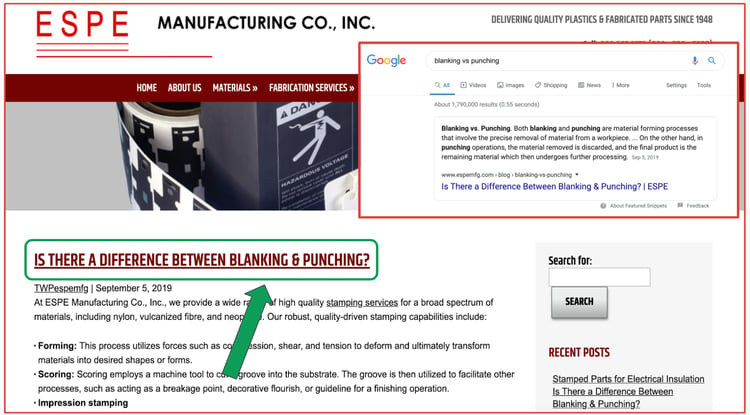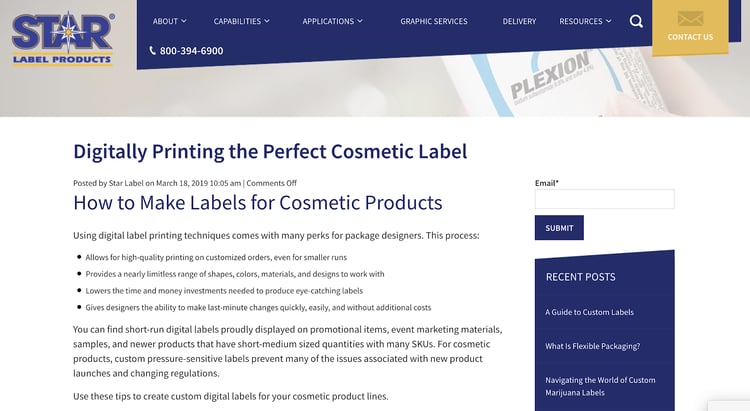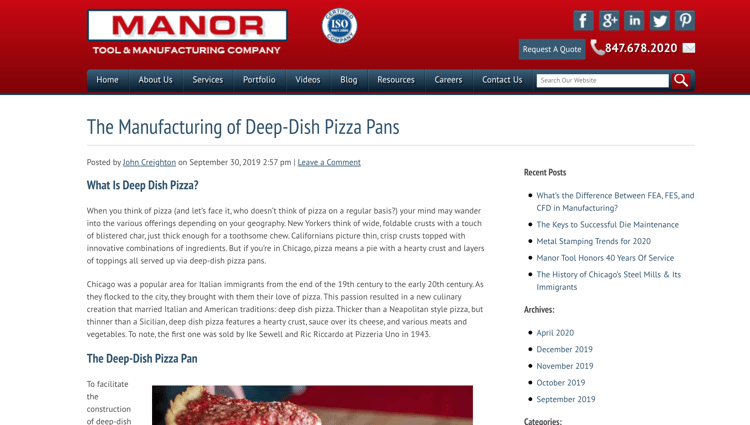Industrial Marketing Content: Ideas To Continue Success After Your First Campaign
Armani Goens & Ryan Gurian September 9, 2021
Investing in original, quality content creation is essential to website success and high-quality lead generation. If you’ve completed your first content marketing campaign and are looking for more industrial marketing content ideas to take your lead generation strategy to the next level, check out the below tips.
 Use Google Search Console And Google Trends For Content Ideas
Use Google Search Console And Google Trends For Content Ideas
Using a data-driven approach is key to upgrading your content marketing strategy for lead generation. If you’re partnered with an industrial marketing agency, they will likely use Google Search Console to inform you about the health of your website and if there are any loading or security or server issues. The longer you use the Search Console, the more helpful it becomes for content creation. The amount of information Search Console collects over the first year of use can be used to optimize rankings of current webpages and find new key terms your visitors are using during their online searches.
Think of Search Console as an insight into your customers’ heads. You’ll be able to gain a deeper understanding of the type of content they’re looking for and the challenges they’re experiencing.
Google Trends is a free tool that gives you insight into buyer needs too, by helping you understand the relative popularity of a search term over time. It will help you plan seasonal demand, understand geographic trends and new markets, and provide trendy content ideas. If you’re a manufacturer targeting local buyers, you can use Google Trends to find terms that people are searching for within the area you’re targeting and create content using those keywords.
Content Brainstorming Sessions
Remember the value of a human connection. Team brainstorming sessions are a great way to get inspired by other people and gather a broad range of creative ideas. Brainstorm ideas with your entire company — from your shop floor workers to your customer service representatives. And that's okay if you don't have a large team to bounce ideas off of — you can still create great ideas with one other colleague. You’d be surprised how many new ideas you can come up with when you bring more people together collaboratively.
Diversity is key to new ideas. Gwynne Shotwell, President and COO of SpaceX says, "If everybody in the room looks the same, thinks the same, came from the same university, had the same background, they’re gonna come up with the same answer."
Invite members who have no previous familiarity with the project, as well as the direct project team to get extra input. Including people who don’t have any preconceptions about the project incorporates fresh perspectives and creative ideas — just be sure to outline the parameters before starting the session.
Once the brainstorming session is underway, keep the following items in mind:
- Use fun activities to get people engaged and their creative juices flowing
- Motivate your team by asking "why." Help your employees understand the purpose of what you're asking and that they're doing important work
- Be open to any and all ideas — you never know how something can be incorporated into the overall plan or inspire another concept
- Find things that really “light a spark” — they’ll seize people’s interest and inspire people
- Write down everything either on a whiteboard, paper, or electronically on your computer to make sure you record all ideas discussed; these can be referenced later for future projects or for backup ideas and even shared for new inspiration on other projects
- Don't forget about your audience! Think about the challenges of your B2B buyers, procurement managers, and engineers. This will help you create quality, engaging content they're looking for.
We did a little research for you. Get started with the below information about B2B buyers:
By understanding how to meet the needs of your buyers, you can better position yourself as a trusted partner to earn their business with the content on your website.
TranPak is a manufacturer & distributor of standard & custom plastic pallets, bins, liquid containers & cases. Christian Ueland, TrankPak President, wanted to become more visible to the right people: relevant purchasing agents and other industrial buyers ready to place an order.
A conversation with advertising executives and qualified engineers at Thomas revealed the companies searching for custom plastic pallets and how TranPak could reach those audiences.
➡️ Discover which buyers you could be doing business with — request your free in-market buyer activity report here.
“The leads that we get from Thomasnet.com are qualified. They're purchasing agents that are serious about our products and we grew our business by 24%,” said Christian.
Competitive Research
Another helpful approach to creating quality website content is to carefully research what your competitors are doing for their own marketing strategies. There are two main categories of competitors to watch out for: traditional competitors who are typically located within close physical proximity and competitors who may not be physically close but who will appear on the same search engine results pages as your company. Regardless of competitor type, it can be beneficial to see what’s working elsewhere in the market and what your intended audience is responding to.
💡 Thomas Tip: See how your website compares against a competitor with our free digital health check. "We are extremely pleased with our quality of traffic thanks to Thomas," said Norman Rodriques, President, Springfield Spring Corporation. "New RFQs come in so often we have trouble keeping up. Even more astonishing is the quality of the leads and the number of new customers we have converted."
Refine Your Existing Content
A website that offers relevant information stands to gain the most visibility online. Google increases your website ranking when you strategically update your landing pages and blog, so after your first content marketing campaign, it’s time to optimize your existing content. This means analyzing your existing content based on performance metrics and refining your best-performing assets. The idea is to “drill down” on particular aspects of your business to improve the main ideas of the content you have set in place.
Look for details throughout your website that speak to your greater capabilities. For example, if you provide Metal Fabrication, try brainstorming topics about what specific metals are used for metal fabrication. Take it a step further and create content about one metal in particular and why it’s advantageous to use it for one project.
Comparison Industrial Content
Think about the materials or processes and the machinery or equipment used together. Google a keyword that pertains to what you do and add “vs.” — for example, ESPE Manufacturing created a blog “Is There A Difference Between Blanking And Punching?” The post now ranks #1 on Google for the keyword search “blanking vs punching.”
Comparison content is great for any user doing their research on how best to complete their projects. Aim to create content that clarifies commonly known processes, while strategically anticipating search user intent. It’s important not to bad-mouth a competitor in these types of content pieces. Instead, highlight the subtle differences or the processes or materials and note where each may be applied. It's key not to favor one over the other, especially if you’re a manufacturer that offers both services or processes. Comparison content should be educational in tone, instead of competitive.

Industry-Specific Content
Create content about the specific industries your manufacturing business caters to. This type of content strategy incorporates long-tail keywords, like:
- Metal stamping for aerospace
- Cable assemblies for medical devices
- Injection molding for the food & beverage industry
See how Star Label Products created content on how their manufacturing capabilities solve industry-specific challenges. They have guides on custom cosmetic labels, custom beer labels, household products, etc. Think outside-of-the-box — the manufacturing industry is so vast and expansive that it’s found everywhere. There are many creative opportunities for you to tell your manufacturing brand story.

Manor Tool and Company wrote a blog on “The Manufacturing Of Deep Dish Pizza Pans.” These posts are interesting to read, satisfy the demand for content, exemplify your manufacturing capabilities, and appeal to search engines all at once.

Other Content Opportunities
Cover as much “digital ground” as possible to increase your SEO traffic. Create:
- Glossaries
- Checklists & Troubleshooting Guides
- An FAQ page
- Project pages & image galleries
- Material lists
Content ideas are endless, so make sure the content you’re creating lets buyers see you as a thought leader in the industry.
Promote Your Content
At this point in your content creation process, it’s time to promote your content to increase its reach. The content on your website, social media platforms, and Thomas Network Company Profile is what sets you apart from the competition. Remember, it’s important to be everywhere your buyers are, so you’ll want to make sure your content is published all on the platforms your potential customers are. Social media platforms like LinkedIn and YouTube can be powerful for manufacturers, as well as Google reviews — so remember to keep your Google Business profile up to date.
💡 Thomas Tip: Your information on Thomasnet.com can get seen by more than 1.3 million in-market B2B buyers sourcing new suppliers. “Qualified leads are coming to us now, and since prospects can easily search our capabilities and qualifications (on Thomasnet.com), those who contact us are more inclined to do business with us,” said Bill Boyer, CEO of Boyer Machine & Tool Co., Inc.
“One of the underlying themes, as well as obligations, to market in our B2B ecosystem is to share our expertise,” said Jason Kline, Director of Marketing at Consolidated Electronic Wire & Cable. He stressed the marketing strategy isn’t just about branding at Consolidated, but rather engaging with customers and potential customers with a myriad of useful approaches to content. “Our partners at Thomas help us to develop meaningful content that can aid folks through the buying process in our industry. Whether you’re a first-year procurement manager or a twenty-five-year engineer, we’ve got direction to help you make educated decisions and that's been helping our company grow.”
Valuable, insightful content attracts readers, sparks word-of-mouth, and gets businesses found. Contact our industrial marketing team to get custom insight into how you can grow your business better. 
And for more industrial marketing content ideas that get engagement from B2B buyers, engineers, and procurement professionals, check out the resources below:
- Free video content creation services with the purchase of an advertising program
- Blog: The Basics Of Content Marketing For Manufacturers
- Blog: 5 Easy Tips For Creating A Lead-Generating eBook
- Blog: How To Meet The Needs Of Industrial Buyers
- Report: 2021 Industrial Buyer's Search Habits Survey Results
Did you find this useful?











